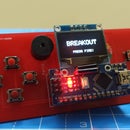Introduction: How to Make LED Chaser
In this article you will learn, how to make an LED chaser using 4017 easily with less number of components.
Lets gets started.
Step 1: About IC 4017
Let us now introduce you a new IC named IC 4017. It is a CMOS decade counter cum decoder circuit which can work out of the box for most of our low range counting applications. It can count from zero to ten and its outputs are decoded. This saves a lot of board space and time required to build our circuits when our application demands using a counter followed by a decoder IC. This IC also simplifies the design and makes debugging easy.
Pin-1: It is the output 5. It goes high when the counter reads 5 counts.
Pin-2: It is the output 1. It goes high when the counter reads 0 counts.
Pin-3: It is the output 0. It goes high when the counter reads 0 counts.
Pin-4: It is the output 2. It goes high when the counter reads 2 counts.
Pin-5: It is the output 6. It goes high when the counter reads 6 counts.
Pin-6: It is the output 7. It goes high when the counter reads 7 counts.
Pin-7: It is the output 3. It goes high when the counter reads 3 counts.
Pin-8: It is the Ground pin which should be connected to a LOW voltage (0V).
Pin-9: It is the output 8. It goes high when the counter reads 8 counts.
Pin-10: It is the output 4. It goes high when the counter reads 4 counts.
Pin-11: It is the output 9. It goes high when the counter reads 9 counts.
Pin-12: This is divided by 10 output which is used to cascade the IC with another counter so as to enable counting greater than the range supported by a single IC 4017. By cascading with another 4017 IC, we can count up to 20 numbers. We can increase and increase the range of counting by cascading it with more and more IC 4017s. Each additional cascaded IC will increase the counting range by 10. However, it is not advisable to cascade more than 3 ICs as it may reduce the reliability of the count due to the occurrence glitches. If you need a counting range more than twenty or thirty, I advise you to go with conventional procedure of using a binary counter followed by a corresponding decoder.
Pin-13: This pin is the disable pin. In normal mode of operation, this is connected to ground or logic LOW voltage. If this pin is connected to logic HIGH voltage, then the circuit will stop receiving pulses and so it will not advance the count irrespective of number of pulses received from the clock.
Pin-14: This pin is the clock input. This is the pin from where we need to give the input clock pulses to the IC in order to advance the count. The count advances on the rising edge of the clock.
Pin-15: This is the reset pin which should be kept LOW for normal operation. If you need to reset the IC, then you can connect this pin to HIGH voltage.
Pin-16: This is the power supply (Vcc) pin. This should be given a HIGH voltage of 3V to 15V for the IC to function.
This IC is very useful and also user friendly. To use the IC, just connect it according the specifications described above in the pin configuration and give the pulses you need to count to the pin-14 of the IC. Then you can collect the outputs at the output pins. When the count is zero, Pin-3 is HIGH. When the count is 1, Pin-2 is HIGH and so on as described above.
Step 2: Components Required
LEDs – 10
Tri Color LED – 1
2.8K Resistor
IC 4017
PCB or Breadboard
Step 3: Watch Video - Step by Step Instructions
Don’t fear, you will make this projects easily. I will instruct you step by step. Get all the components. Watch the video and start building. Its easy!
Step 4: Circuit
In normal led chasers for triggering 4017 ic we use 555 timer. But in this led chaser project we don’t use 555 timer for triggering. Instead we use tri color led for triggering. Here tricolor led uses different voltage levels for each color. By using this phenomenon, we will add a resistor, so that led doesn’t have sufficient voltage level to glow for a color and pulls to low and acts as trigger.
Connect the components according to schematic. Watch video for step by step instructions.
Step 5: That's All
I hope you like this instructables. Give support by Subscribing my YouTube Channel- Tech Maker
Visit my website for more projects Electronics Projects Hub

Participated in the
Make it Glow Contest 2018











